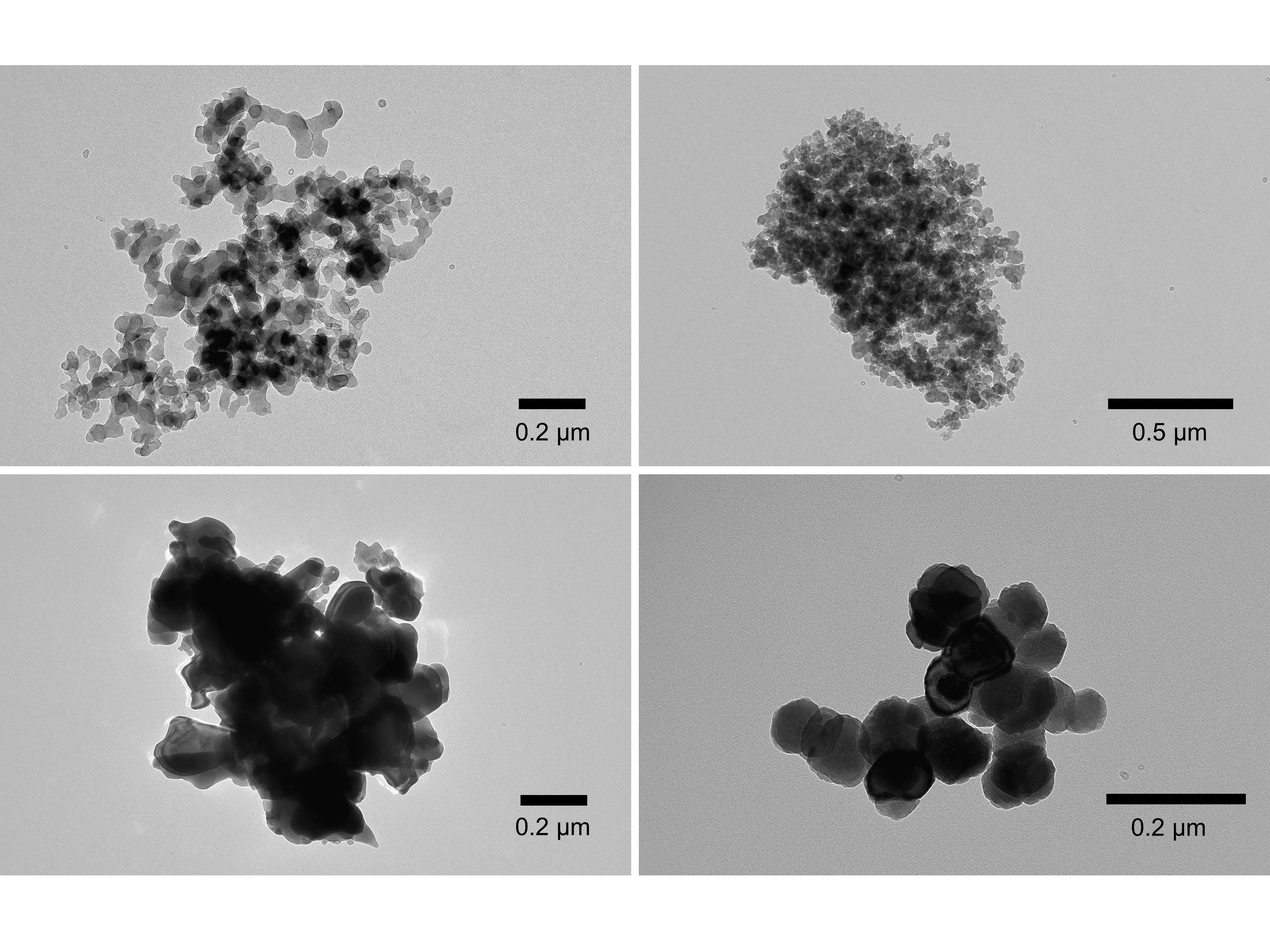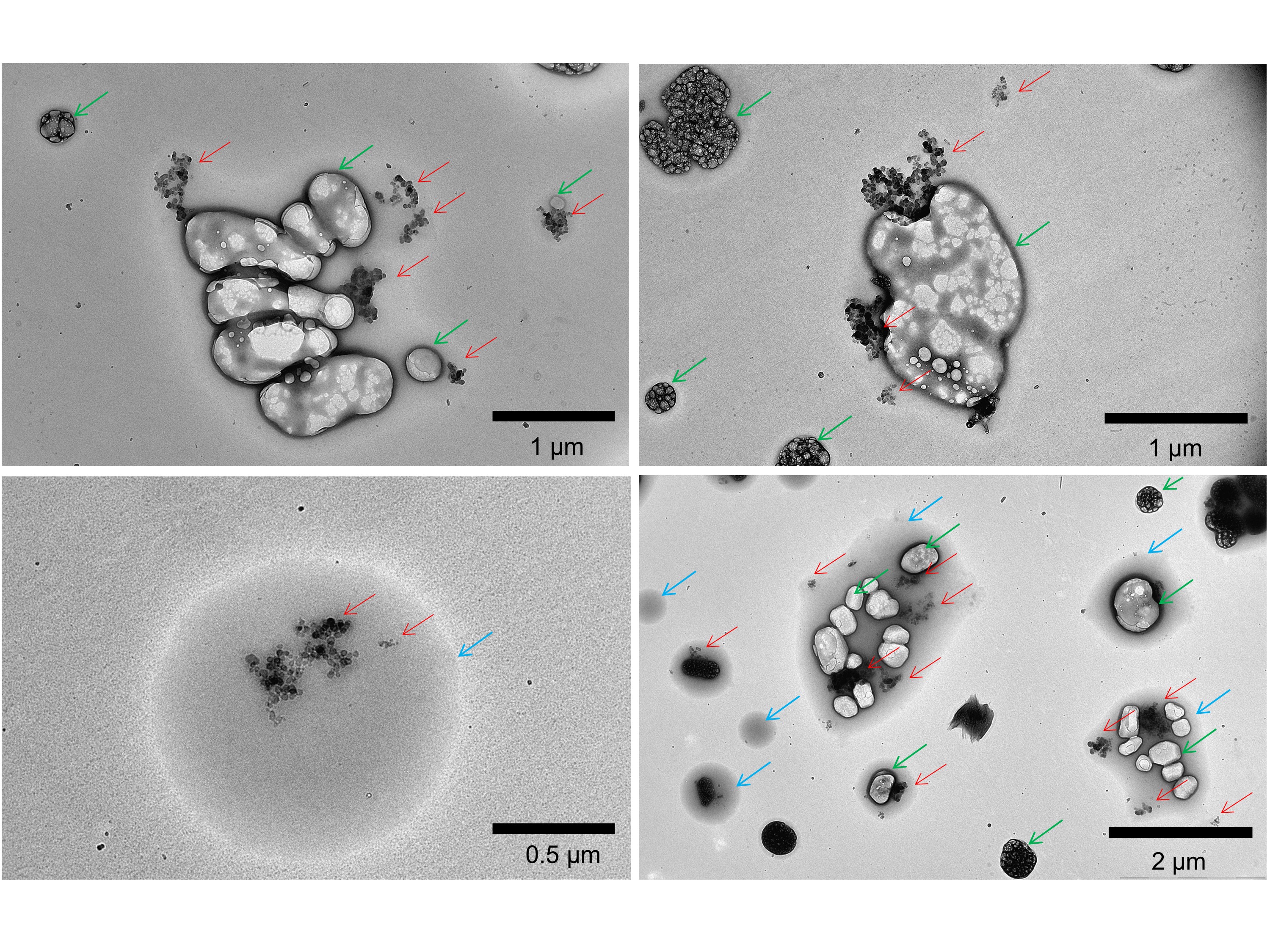From The University of Tokyo [(東京大学](JP)
5.3.23
MOTEKI Nobuhiro
Research Associate
Graduate School of Science

Black carbon from the lab. Transmission electron microscope images of laboratory powder samples. Clockwise from top left, fullerene soot, black carbon aggregate from vehicle exhaust, Hematite-TD and Hematite-KJ. ©2023 Moteki et al. CC-BY

Ambient aerosols. Transmission electron microscope images of ambient aerosols collected by an aerosol-impactor sampler installed on the research vessel Shinsei Maru. Red arrows indicate individual black carbon aggregates, most of which were mixed with sulfate (green arrows) and/or organic materials (light blue arrows). ©2023 Moteki et al. CC-BY
Our industrialized society releases many and various pollutants into the world. Combustion in particular produces aerosol mass including black carbon. Although this only accounts for a few percent of aerosol particles, black carbon is especially problematic due to its ability to absorb heat and impede the heat reflection capabilities of surfaces such as snow. So, it’s essential to know how black carbon interacts with sunlight. Researchers have quantified the refractive index of black carbon to the most accurate degree yet which might impact climate models.
There are many factors driving climate change; some are very familiar, such as carbon dioxide emissions from burning fossil fuels, sulfur dioxide from cement manufacture or methane emissions from animal agriculture. Black carbon aerosol particles, also from combustion, are less covered in the news but are particularly important. Essentially soot, black carbon is very good at absorbing heat from sunlight and storing it, adding to atmospheric heat. At the same time, given dark colors are less effective at reflecting light and therefore heat, as black carbon covers lighter surfaces including snow, it reduces the potential of those surfaces to reflect heat back into space.
“Understanding the interaction between black carbon and sunlight is of fundamental importance in climate research,” said Assistant Professor Nobuhiro Moteki from the Department of Earth and Planetary Science at the University of Tokyo. “The most critical property of black carbon in this regard is its “refractive index”, basically how it redirects and disperses incoming light rays. However, existing measurements of black carbon’s refractive index were inaccurate. My team and I undertook detailed experiments to improve this. With our improved measurements, we now estimate that current climate models may be underestimating the absorption of solar radiation due to black carbon by a significant 16%.”
Previous measurements of the optical properties of black carbon were often confounded by factors such as lack of pure samples, or difficulties in measuring light interactions with particles of differing complex shapes. Moteki and his team improved this situation by capturing the black carbon particles in water, then isolating them with sulfates or other water-soluble chemicals. By isolating the particles, the team was better able to shine light on them and analyze the way they scatter, which gave researchers the data to calculate the value of refractive index.
“We measured the amplitude, or strength, and phase, or step, of the light scattered from black carbon samples isolated in water,” said Moteki. “This allowed us to calculate what is known as the complex refractive index of black carbon. Complex because rather than being a single number, it’s a value that contains two parts, one of which is ‘imaginary’ (concerned with absorption), though its impact is very, very real. Such complex numbers with imaginary components are actually very common in the field of optical science and beyond.”
As the new optical measurements of black carbon imply that current climate models are underestimating its contribution to atmospheric warming, the team hopes that other climate researchers and policymakers can make use of their findings. The method developed by the team to ascertain the complex refractive index of particles can be applied to materials other than black carbon. This allows for the optical identification of unknown particles in the atmosphere, ocean or ice cores, and the evaluation of optical properties of powdered materials, not just those related to the ongoing problem of climate change.
Aerosol Science and Technology
Figure 1. Schematic diagram of the complex amplitude sensor for waterborne particles. A linearly polarized 2 mW He-Ne laser with λ = 0.633 μm was used for generating high-wavefront quality Gaussian laser beam. An optical isolator was used to prevent laser instability due to back reflections. Each pair of rotatable half-wave plates (HWPs) with polarization beam splitters (PBSs) was used to split the beam with a controlled power ratio. The beam optics in the s- and l-channels are configured to quantify the complex forward-scattering amplitude of the sub- and super-micron particle size range, respectively. Table S1 lists the models and manufacturers of all the optical components in this schematic.

See the full article here .
Comments are invited and will be appreciated, especially if the reader finds any errors which I can correct. Use “Reply”.
five-ways-keep-your-child-safe-school-shootings
Please help promote STEM in your local schools.
The University of Tokyo [(東京大学](JP) aims to be a world-class platform for research and education, contributing to human knowledge in partnership with other leading global universities. The University of Tokyo aims to nurture global leaders with a strong sense of public responsibility and a pioneering spirit, possessing both deep specialism and broad knowledge. The University of Tokyo aims to expand the boundaries of human knowledge in partnership with society. Details about how the University is carrying out this mission can be found in the University of Tokyo Charter and the Action Plans.
The university has ten faculties, 15 graduate schools and enrolls about 30,000 students, 2,100 of whom are international students. Its five campuses are in Hongō, Komaba, Kashiwa, Shirokane and Nakano. It is among the top echelon of the select Japanese universities assigned additional funding under the MEXT’s Top Global University Project to enhance Japan’s global educational competitiveness.
University of Tokyo is considered to be the most selective and prestigious university in Japan and is counted as one of the best universities in the world. As of 2018, University of Tokyo’s alumni, faculty members and researchers include seventeen Prime Ministers, sixteen Nobel Prize laureates, three Pritzker Prize laureates, three astronauts, and a Fields Medalist.
The university was chartered by the Meiji government in 1877 under its current name by amalgamating older government schools for medicine, various traditional scholars and modern learning. It was renamed “the Imperial University [帝國大學]” in 1886, and then Tokyo Imperial University [東京帝國大學]] in 1897 when the Imperial University system was created. In September 1923, an earthquake and the following fires destroyed about 700,000 volumes of the Imperial University Library. The books lost included the Hoshino Library [星野文庫], a collection of about 10,000 books. The books were the former possessions of Hoshino Hisashi before becoming part of the library of the university and were mainly about Chinese philosophy and history.
In 1947 after Japan’s defeat in World War II it re-assumed its original name. With the start of the new university system in 1949, Todai swallowed up the former First Higher School (today’s Komaba campus) and the former Tokyo Higher School, which thenceforth assumed the duty of teaching first- and second-year undergraduates, while the faculties on Hongo main campus took care of third- and fourth-year students.
Although the university was founded during the Meiji period, it has earlier roots in the Astronomy Agency [天文方] 1684), Shoheizaka Study Office [昌平坂学問所] 1797), and the Western Books Translation Agency [蕃書和解御用] 1811). These institutions were government offices established by the Tokugawa shogunate [徳川幕府] (1603–1867), and played an important role in the importation and translation of books from Europe.
In the fall of 2012 and for the first time, the University of Tokyo started two undergraduate programs entirely taught in English and geared toward international students—Programs in English at Komaba (PEAK)—the International Program on Japan in East Asia and the International Program on Environmental Sciences. In 2014, the School of Science at the University of Tokyo introduced an all-English undergraduate transfer program called Global Science Course (GSC).
Research
The University of Tokyo is considered a top research institution of Japan. It receives the largest amount of national grants for research institutions, Grants-in-Aid for Scientific Research, receiving 40% more than the University with 2nd largest grants and 90% more than the University with 3rd largest grants. This massive financial investment from the Japanese government directly affects Todai’s research outcomes. According to Thomson Reuters, Todai is the best research university in Japan. Its research excellence is especially distinctive in Physics (1st in Japan, 2nd in the world); Biology & Biochemistry (1st in Japan, 3rd in the world); Pharmacology & Toxicology (1st in Japan, 5th in the world); Materials Science (3rd in Japan, 19th in the world); Chemistry (2nd in Japan, 5th in the world); and Immunology (2nd in Japan, 20th in the world).
In another ranking, Nikkei Shimbun on 16 February 2004 surveyed about the research standards in Engineering studies based on Thomson Reuters, Grants in Aid for Scientific Research and questionnaires to heads of 93 leading Japanese Research Centers. Todai was placed 4th (research planning ability 3rd/informative ability of research outcome; 10th/ability of business-academia collaboration 3rd) in this ranking. Weekly Diamond also reported that Todai has the 3rd highest research standard in Japan in terms of research fundings per researchers in COE Program. In the same article, it is also ranked 21st in terms of the quality of education by GP funds per student.
Todai also has been recognized for its research in the social sciences and humanities. In January 2011, Repec ranked Todai’s Economics department as Japan’s best economics research university. And it is the only Japanese university within world top 100. Todai has produced 9 presidents of the Japanese Economic Association, the largest number in the association. Asahi Shimbun summarized the number of academic papers in Japanese major legal journals by university, and Todai was ranked top during 2005–2009.
Research institutes
Institute of Medical Science
Earthquake Research Institute
Institute of Advanced Studies on Asia
Institute of Social Science
Institute of Industrial Science
Historiographical Institute
Institute of Molecular and Cellular Biosciences
Institute for Cosmic Ray Research
Institute for Solid State Physics
Atmosphere and Ocean Research Institute
Research Center for Advanced Science and Technology
The University’s School of Science and the Earthquake Research Institute are both represented on the national Coordinating Committee for Earthquake Prediction.



